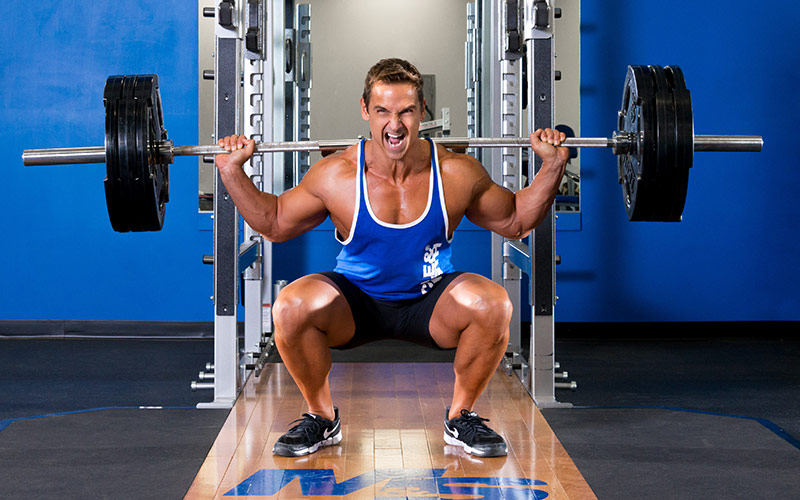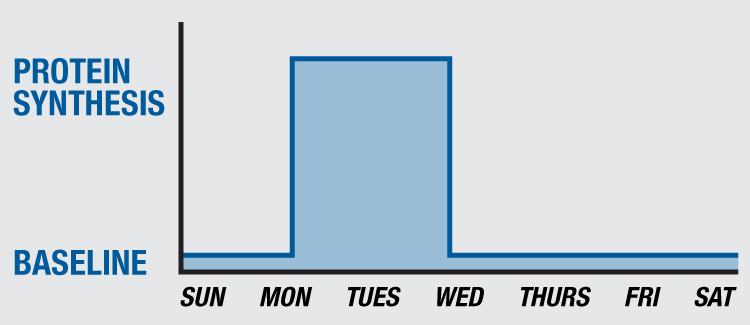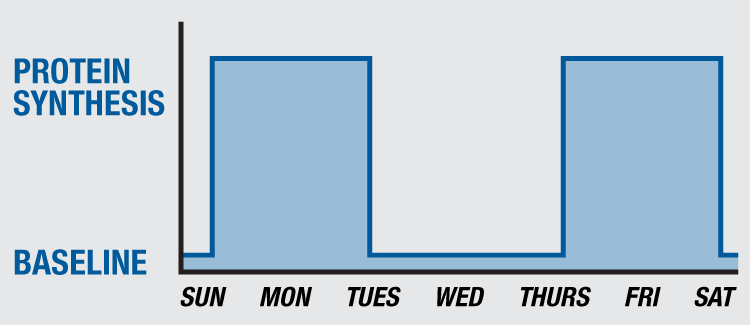01dragonslayer
Ripped
- Jacked Cash
- 485,351
This workout combines the main mechanisms of muscle hypertrophy to help you build some serious muscle. Try this split to put on quality summer mass!
This 5 day routine is strategically designed to produce adaptations using the 2 main mechanisms of muscle hypertrophy: mechanical tension and muscle damage.1
Related: Total Body Beatdown - A German Volume Training Routine
The tension necessary to produce this result is typically found in the 8-12 rep range – where intensity is still relatively high, but due to the higher volume, the muscle is placed under tension for a prolonged period of time.
The method by which the program works is quite simple; the stress produced by your mechanical tension training days will increase strength. The adaptations from your heavier lifting days will then allow you be stronger in your hypertrophy training – allowing for even more muscle damage (which creates muscle growth).
More muscle mass equals more strength – and thus it becomes a vicious cycle of gains.

The research has made it very clear that the most critical pathway to building new muscle is progressive overload.4 The simplest and most practical way to achieve progressive overload is through increasing your total volume .
This can be accomplished by performing more reps without sacrificing the intensity, or increasing the intensity (weight used) without sacrificing the volume (sets x reps).
Related: Arnold Schwarzenegger Volume Workout Routines
In this program the goal for progression with your main lifts (e.g. bench press, overhead press, deadlift, and squat) will be the latter. However, when it comes to smaller isolation or auxiliary movements (e.g. bicep curls, pushdowns, etc.), the former may be a more viable method (more on that later).
The low and moderate rep groups produced significantly more hypertrophy than the high rep group – proving the importance of training at a higher intensity when strength and muscle growth are the goal.
Muscle protein synthesis then begins to drop back to baseline at about the 36 hour mark.
Take for example an athlete who trains his chest directly, 1 time per week: he’ll elevate muscle protein synthesis just 1 time (see the chart below).

For an athlete who trains with using a higher frequency program like MAUL, he will bench press 2 times throughout the week, elevating protein synthesis twice as much as the athlete who trained his chest just once (see the chart below).

With the accessory lifts, you’ll notice there is a repetition range (i.e. 10-12). The goal is to complete each set, for the higher end of the prescribed reps. Once you’ve accomplished that, increase the weight slightly and repeat.
Related: Never Stop Making Gains! Use Micro-Progressions For Growth
If you fall short, continue next week using the same weight and aim to outperform your last performance.
Repeat that until you’ve managed to hit every set for the high end of the prescribed reps.
Direct abdominal training is recommended but not required. Feel free to include direct ab training after your workouts or on rest days.
WORKOUT SUMMARY
- Main Goal
Build Muscle - Workout Type
Split - Training Level
Beginner - Program Duration12 weeks
- Days Per Week
5 - Time Per Workout45-60 minutes
- Equipment Required
Barbell, Cables, Dumbbells, Machines - Target GenderMale & Female
- Workout PDFDownload Workout
Workout Description
The MAUL program is based on the time tested, proven principles of strength and muscle growth.This 5 day routine is strategically designed to produce adaptations using the 2 main mechanisms of muscle hypertrophy: mechanical tension and muscle damage.1
What is Mechanical Stress?
Mechanically induced tension produced both by force generation and stretch. This stress is typically formed when lifting at a high intensity (i.e. 1-5 repetitions). Mechanical stress has been shown to produce the greatest increases in strength.2What Is Muscle Damage?
Localized damage to muscle tissue which generates a hypertrophic response.Related: Total Body Beatdown - A German Volume Training Routine
The tension necessary to produce this result is typically found in the 8-12 rep range – where intensity is still relatively high, but due to the higher volume, the muscle is placed under tension for a prolonged period of time.
What is Undulating Periodization?
Varying your rep ranges and/or intensity from session to session has been shown to produce greater strength gains than the traditional linear periodization model.3The method by which the program works is quite simple; the stress produced by your mechanical tension training days will increase strength. The adaptations from your heavier lifting days will then allow you be stronger in your hypertrophy training – allowing for even more muscle damage (which creates muscle growth).
More muscle mass equals more strength – and thus it becomes a vicious cycle of gains.

What is Volume?
Volume is represented by the equation (Sets x Reps x Weight Lifted = Total Volume).The research has made it very clear that the most critical pathway to building new muscle is progressive overload.4 The simplest and most practical way to achieve progressive overload is through increasing your total volume .
This can be accomplished by performing more reps without sacrificing the intensity, or increasing the intensity (weight used) without sacrificing the volume (sets x reps).
Related: Arnold Schwarzenegger Volume Workout Routines
In this program the goal for progression with your main lifts (e.g. bench press, overhead press, deadlift, and squat) will be the latter. However, when it comes to smaller isolation or auxiliary movements (e.g. bicep curls, pushdowns, etc.), the former may be a more viable method (more on that later).
What is Intensity?
Intensity is the amount of physical power the body uses to perform a lift. A 2002 study conducted on 32 men compared low, moderate, and high rep training.5The low and moderate rep groups produced significantly more hypertrophy than the high rep group – proving the importance of training at a higher intensity when strength and muscle growth are the goal.
What is Training Induced MPS?
The synthesis of muscle protein is essential to the body’s ongoing growth, repair, and maintenance of its skeletal muscle. Studies suggest that muscle protein synthesis is more than doubled at about 24 hours following an intense training bout.6Muscle protein synthesis then begins to drop back to baseline at about the 36 hour mark.
Take for example an athlete who trains his chest directly, 1 time per week: he’ll elevate muscle protein synthesis just 1 time (see the chart below).

For an athlete who trains with using a higher frequency program like MAUL, he will bench press 2 times throughout the week, elevating protein synthesis twice as much as the athlete who trained his chest just once (see the chart below).

What is The Repeated Bout Effect?
Research has demonstrated that when we train a muscle group more frequently (to a degree) it increases our ability to recover and adapt. This is known as the repeated bout effect.7 More efficient recovery and adaptation makes for: extended progression without a plateau, linear strength increases, and more overall muscle growth.what method of Progression do we use?
The method of progression with the heavier compound lifts is simple: increase the weight slightly, each week, without sacrificing volume.With the accessory lifts, you’ll notice there is a repetition range (i.e. 10-12). The goal is to complete each set, for the higher end of the prescribed reps. Once you’ve accomplished that, increase the weight slightly and repeat.
Related: Never Stop Making Gains! Use Micro-Progressions For Growth
If you fall short, continue next week using the same weight and aim to outperform your last performance.
Repeat that until you’ve managed to hit every set for the high end of the prescribed reps.
Day 1 Upper Body Mechanical Stress
| Exercise | Sets | Reps |
|---|---|---|
| 1. Bench Press | 3 | 5 |
| 2. Incline Dumbbell Press | 3 | 6 |
| 3. Rack Pulls | 3 | 5 |
| 4. Seated Row | 3 | 8-10 |
| 5. Overhead Press | 3 | 6 |
| 6. Barbell Shrug | 3 | 6-8 |
| 7. Barbell Curl | 3 | 8-10 |
| 8. Close Grip Bench Press | 3 | 8-10 |
Day 2 Lower Body Mechanical Stress
| Exercise | Sets | Reps |
|---|---|---|
| 1. Squat | 3 | 5 |
| 2. Leg Press | 3 | 6 |
| 3. Stiff-Legged Deadlift | 3 | 8-10 |
| 4. Hamstring Curl | 3 | 10-12 |
| 5. Calf Raise | 3 | 10-12 |
Day 3 Upper Body [a] Muscle Damage
| Exercise | Sets | Reps |
|---|---|---|
| 1. Deadlift | 2 | 5 |
| 2. Bench Press | 3 | 10 |
| 3. Cable Cross-Over (Low to High) | 4 | 12-15 |
| 4. Bent Barbell Rows | 4 | 10-12 |
| 5. Lat Pulldown | 4 | 12-15 |
| 6. Barbell Shrug | 4 | 10-12 |
Day 4 Upper Body Muscle Damage
| Exercise | Sets | Reps |
|---|---|---|
| 1. Overhead Press | 3 | 10 |
| 2. Dumbbell Shoulder Press | 2 | 12 |
| 3. Lateral Raise | 4 | 12-15 |
| 4. Face Pull | 4 | 12-15 |
| 5. Barbell Curl | 4 | 10-12 |
| 6. Incline Curl | 4 | 12-15 |
| 7. Rope Pushdown | 4 | 10-12 |
| 8. Overhead Triceps Extension | 4 | 12-15 |
Day 5 Lower Body Muscle Damage
| Exercise | Sets | Reps |
|---|---|---|
| 1. Squat | 3 | 10 |
| 2. Leg Press | 3 | 12 |
| 3. Leg Extension | 4 | 10-12 |
| 4. Hamstring Curl | 4 | 10-12 |
| 5. Calf Raise | 3 | 10-12 |

